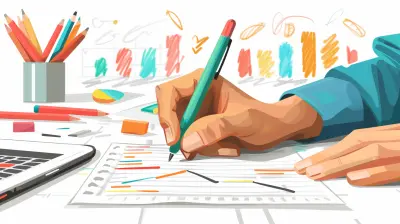The Role of Social Stories in Supporting Students with Autism
19 November 2025
Let’s face it—navigating the social world isn’t always easy. For many of us, picking up on social cues, understanding body language, or figuring out what someone really means comes pretty naturally. But for students with autism, this seemingly "built-in" skill doesn't always come standard. That’s where social stories come in. They act like a GPS for social interaction—offering step-by-step directions through situations that might otherwise feel overwhelming or confusing.
So, what are these magical tools, and how exactly do they support students with autism? Let’s break it down together.
What Are Social Stories?
Imagine walking into a room where you don’t know the rules, the expectations, or what’s going to happen next. That uncertainty can be stressful, right? Now imagine if someone handed you a guidebook explaining exactly what to expect and how to act—suddenly, the unknown isn’t so scary.That’s the basic idea behind social stories.
Social stories are short, personalized narratives designed to teach individuals—particularly those on the autism spectrum—about specific social situations, behaviors, or skills. Created by Carol Gray in the early 1990s, these stories aim to provide clarity and predictability by explaining social norms in a simple, straightforward way.
They often answer questions like:
- “What happens during recess?”
- “Why do I have to wait my turn?”
- “How do I ask to play with someone?”
Each story is tailored to the child’s needs and covers who, what, when, where, and why—kind of like a guidebook for life's trickier moments.
Why Do Students with Autism Need Social Stories?
Let’s dig deeper. Why are these stories even necessary?Students with autism often have challenges with:
- Understanding social cues
- Reading body language or facial expressions
- Managing unexpected changes or transitions
- Expressing themselves appropriately
This can lead to feelings of frustration, anxiety, or isolation, especially in group settings like classrooms or playgrounds.
Social stories step in like a helpful big sibling. They "translate" complex social scenarios into bite-sized, understandable pieces. They prep students ahead of time, reducing anxiety and boosting confidence. It’s like practicing a play before the final performance—you know your lines, cues, and what to expect.
The Key Elements of Effective Social Stories
Not all social stories are created equal. To have the intended impact, they need certain key ingredients.Here’s what makes them tick:
1. Personalization
The story should be tailored to the individual. That means using the student’s name, incorporating familiar settings, and reflecting their actual experiences.For example: _“When Maya goes to the lunchroom, she waits in line to get her food.”_
See? It brings the scenario to life from the child's point of view.
2. Simple, Clear Language
Keep the wording direct and easy to follow. Using complicated jargon or abstract concepts just creates more confusion.Use sentence types like:
- Descriptive: What happens typically? (e.g., "The bell rings at 3:00 PM.")
- Perspective: How do others feel? (e.g., "Teachers feel happy when students listen.")
- Directive: What should the child do? (e.g., "I will raise my hand to ask a question.")
3. Positive Focus
Don't just highlight what not to do. Instead, focus on the desirable behavior and its benefits. The goal is to set the child up for success, not shame them for past mistakes.4. Visual Support
Pictures, symbols, or even digital animations can enhance understanding—especially for visual learners. You can even create social stories using apps or slide shows.
Real-Life Scenarios Where Social Stories Shine
You might be wondering—what kinds of situations are social stories most useful for? Honestly, the possibilities are endless, but here are some common applications:1. Navigating New Environments
Imagine starting a new school or visiting the dentist for the first time. For a child with autism, that unknown can feel overwhelming. A social story can paint a clear picture of what to expect.Example: _"When I visit the doctor, I sit in the waiting room. The nurse calls my name. I go into the room and sit on the chair."_
2. Understanding Social Rules
From saying “please” and “thank you” to not interrupting when someone else is talking, social norms aren't always intuitive. Social stories help bridge that gap.Example: _"When someone is talking, I listen and wait for my turn to speak. This makes them feel respected."_
3. Managing Emotions and Behaviors
Meltdowns happen. But social stories can offer coping strategies in advance, so the student has tools they can use when things get tough.Example: _"When I feel upset, I can take deep breaths or ask my teacher for a break."_
4. Handling Transitions and Changes
Whether it’s moving classrooms, changing teachers, or even just going from free time to math class—a transition can feel jarring. Social stories give a preview of what’s coming.Example: _"After recess, I go back into the classroom. I hang up my coat and sit at my desk for reading time."_
How Do You Create a Social Story?
Good news—you don’t need to be a professional author to write a great social story. You just need some patience, creativity, and a good understanding of the student you're writing for.Here’s a simple step-by-step guide:
Step 1: Identify the Social Goal
What skill or behavior are you trying to teach?Be specific. Instead of "Improve behavior," try "Teach Johnny how to ask to play with classmates."
Step 2: Gather Information
Know the environment, triggers, and what typically happens. This helps make the story relatable and realistic.Step 3: Write the Story
Use first-person language ("I"), stick to present tense, and keep sentences short and sweet. Stick with a structure—- Beginning: Set the scene
- Middle: Explain the behavior or situation
- End: Highlight the positive outcome
Example:
> "I like to play on the playground. Sometimes, I want to play with other kids. I can say, 'Can I play too?' If they say yes, we play together."
Step 4: Include Visuals
Photos, illustrations, or even stick-figure drawings work wonders. Visuals help reinforce the message and keep the student engaged.Step 5: Read and Practice
Read the story with the student regularly, especially before the social situation arises. Repetition helps cement the lesson.The Science Behind Social Stories: Do They Really Work?
Let’s be real—you want more than just feel-good fluff. You want to know if social stories actually make a difference. Turns out, they do.Multiple research studies have shown that social stories can lead to:
- Reduced problem behaviors
- Increased social engagement
- Improved emotional regulation
- Better understanding of routines and expectations
It’s not a magic fix, of course. But when used consistently and correctly, social stories can be a powerful tool in a teacher or parent’s toolkit.
Tips for Teachers & Parents Using Social Stories
While creating a social story can be pretty straightforward, using them effectively takes some finesse. Here are a few tips to keep in mind:- Keep it consistent: Read the story regularly, not just once.
- Use it proactively: Introduce the story before the event—not during a meltdown.
- Get the student involved: Let them help create the story, pick pictures, or even illustrate it.
- Celebrate small wins: If the child make progress, cheer them on! Positive reinforcement boosts motivation.
- Be patient: Don’t expect overnight changes. Growth takes time.
Social Stories Go Digital: Modern Tools and Tech
In today’s tech-savvy world, social stories have also gone digital. You can find tons of apps and websites that help create interactive social stories for students with autism.Popular tools include:
- StoryMaker for Social Stories
- Social Stories Creator & Library
- Pictello (iOS)
- ToonDoo or Canva for custom visuals
The cool part? These tools often come with built-in visuals, voice overs, and templates, making it easier for you to build engaging and effective stories in no time.
Final Thoughts
The role of social stories in supporting students with autism is one that can't be overstated. These simple narratives open doors—giving students the tools they need to understand, connect, and thrive in social settings that might otherwise feel out of reach.Think of social stories as social scaffolding. They don’t do the work for the student, but they provide just enough structure so that kids can practice, grow, and eventually stand confidently on their own.
And honestly, isn’t that what every child deserves?
all images in this post were generated using AI tools
Category:
Special EducationAuthor:

Monica O`Neal

